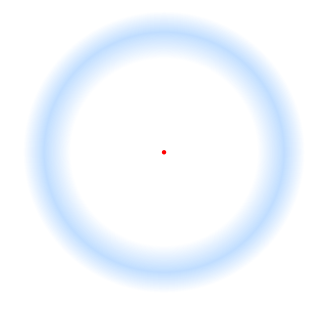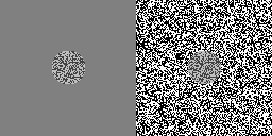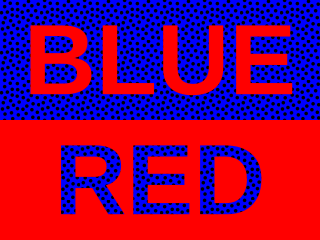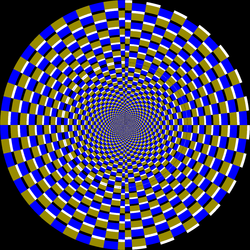Persistence of vision traditionally refers to the optical illusion that occurs when visual perception of an object does not cease for some time after the rays of light proceeding from it have ceased to enter the eye. The illusion has also been described as "retinal persistence", "persistence of impressions", simply "persistence" and other variations. A very commonly given example of the phenomenon is the apparent fiery trail of a glowing coal or burning stick while it is whirled around in the dark.

In visual perception, an optical illusion is an illusion caused by the visual system and characterized by a visual percept that arguably appears to differ from reality. Illusions come in a wide variety; their categorization is difficult because the underlying cause is often not clear but a classification proposed by Richard Gregory is useful as an orientation. According to that, there are three main classes: physical, physiological, and cognitive illusions, and in each class there are four kinds: Ambiguities, distortions, paradoxes, and fictions. A classical example for a physical distortion would be the apparent bending of a stick half immerged in water; an example for a physiological paradox is the motion aftereffect. An example for a physiological fiction is an afterimage. Three typical cognitive distortions are the Ponzo, Poggendorff, and Müller-Lyer illusion. Physical illusions are caused by the physical environment, e.g. by the optical properties of water. Physiological illusions arise in the eye or the visual pathway, e.g. from the effects of excessive stimulation of a specific receptor type. Cognitive visual illusions are the result of unconscious inferences and are perhaps those most widely known.

The Müller-Lyer illusion is an optical illusion consisting of three stylized arrows. When viewers are asked to place a mark on the figure at the midpoint, they tend to place it more towards the "tail" end. The illusion was devised by Franz Carl Müller-Lyer (1857–1916), a German sociologist, in 1889.

Depth perception is the ability to perceive distance to objects in the world using the visual system and visual perception. It is a major factor in perceiving the world in three dimensions. Depth perception happens primarily due to stereopsis and accommodation of the eye.

The term illusory motion, also known as motion illusion or "apparent motion", is an optical illusion in which a static image appears to be moving due to the cognitive effects of interacting color contrasts, object shapes, and position. The stroboscopic animation effect is the most common type of illusory motion and is perceived when images are displayed in fast succession, as occurs in movies. The concept of illusory motion was allegedly first described by Aristotle.

The wagon-wheel effect is an optical illusion in which a spoked wheel appears to rotate differently from its true rotation. The wheel can appear to rotate more slowly than the true rotation, it can appear stationary, or it can appear to rotate in the opposite direction from the true rotation.
Microsaccades are a kind of fixational eye movement. They are small, jerk-like, involuntary eye movements, similar to miniature versions of voluntary saccades. They typically occur during prolonged visual fixation, not only in humans, but also in animals with foveal vision. Microsaccade amplitudes vary from 2 to 120 arcminutes. The first empirical evidence for their existence was provided by Robert Darwin, the father of Charles Darwin.

In vision, filling-in phenomena are those responsible for the completion of missing information across the physiological blind spot, and across natural and artificial scotomata. There is also evidence for similar mechanisms of completion in normal visual analysis. Classical demonstrations of perceptual filling-in involve filling in at the blind spot in monocular vision, and images stabilized on the retina either by means of special lenses, or under certain conditions of steady fixation. For example, naturally in monocular vision at the physiological blind spot, the percept is not a hole in the visual field, but the content is “filled-in” based on information from the surrounding visual field. When a textured stimulus is presented centered on but extending beyond the region of the blind spot, a continuous texture is perceived. This partially inferred percept is paradoxically considered more reliable than a percept based on external input..

The Chubb illusion is an optical illusion or error in visual perception in which the apparent contrast of an object varies substantially to most viewers depending on its relative contrast to the field on which it is displayed. These visual illusions are of particular interest to researchers because they may provide valuable insights in regard to the workings of human visual systems.

Fixation or visual fixation is the maintaining of the gaze on a single location. An animal can exhibit visual fixation if it possess a fovea in the anatomy of their eye. The fovea is typically located at the center of the retina and is the point of clearest vision. The species in which fixational eye movement has been verified thus far include humans, primates, cats, rabbits, turtles, salamanders, and owls. Regular eye movement alternates between saccades and visual fixations, the notable exception being in smooth pursuit, controlled by a different neural substrate that appears to have developed for hunting prey. The term "fixation" can either be used to refer to the point in time and space of focus or the act of fixating. Fixation, in the act of fixating, is the point between any two saccades, during which the eyes are relatively stationary and virtually all visual input occurs. In the absence of retinal jitter, a laboratory condition known as retinal stabilization, perceptions tend to rapidly fade away. To maintain visibility, the nervous system carries out a procedure called fixational eye movement, which continuously stimulates neurons in the early visual areas of the brain responding to transient stimuli. There are three categories of fixational eye movement: microsaccades, ocular drifts, and ocular microtremor. At small amplitudes the boundaries between categories become unclear, particularly between drift and tremor.

Motion Induced Blindness (MIB), also known as Bonneh's illusion is a visual illusion in which a large, continuously moving pattern erases from perception some small, continuously presented, stationary dots when one looks steadily at the center of the display. It was discovered by Bonneh, Cooperman, and Sagi (2001), who used a swarm of blue dots moving on a virtual sphere as the larger pattern and three small yellow dots as the smaller pattern. They found that after about 10 seconds, one or more of the dots disappeared for brief, random times.

Chromostereopsis is a visual illusion whereby the impression of depth is conveyed in two-dimensional color images, usually of red–blue or red–green colors, but can also be perceived with red–grey or blue–grey images. Such illusions have been reported for over a century and have generally been attributed to some form of chromatic aberration.

Akiyoshi Kitaoka is a Professor of Psychology at the College of Letters, Ritsumeikan University, Kyoto, Japan.

Visual perception is the ability to interpret the surrounding environment through photopic vision, color vision, scotopic vision, and mesopic vision, using light in the visible spectrum reflected by objects in the environment. This is different from visual acuity, which refers to how clearly a person sees. A person can have problems with visual perceptual processing even if they have 20/20 vision.
Jocelyn Faubert is a psychophysicist best known for his work in the fields of visual perception, vision of the elderly, and neuropsychology. Professor Faubert holds the NSERC-Essilor Industrial Research Chair in Visual Perception and Presbyopia. He is the director of the Laboratory of Psychophysics and Visual Perception at the University of Montreal. Professor Faubert has also been involved in the award-winning transfer of research and developments from the laboratory into the commercial domain. He is a co-founder and member of the Board of Directors of CogniSens Inc.

A phantom contour is a type of illusory contour. Most illusory contours are seen in still images, such as the Kanizsa triangle and the Ehrenstein illusion. A phantom contour, however, is perceived in the presence of moving or flickering images with contrast reversal. The rapid, continuous alternation between opposing, but correlated, adjacent images creates the perception of a contour that is not physically present in the still images. Quaid et al. have also authored a PhD thesis on the phantom contour illusion and its spatiotemporal limits which maps out limits and proposes mechanisms for its perception centering around magnocellularly driven visual area MT.

Due to the effect of a spatial context or temporal context, the perceived orientation of a test line or grating pattern can appear tilted away from its physical orientation. The tilt illusion (TI) is the phenomenon that the perceived orientation of a test line or grating is altered by the presence of surrounding lines or grating with a different orientation. And the tilt aftereffect (TAE) is the phenomenon that the perceived orientation is changed after prolonged inspection of another oriented line or grating.

Visual processing abnormalities in schizophrenia are commonly found, and contribute to poor social function.

Susana Martinez-Conde is a Spanish-American neuroscientist and science writer. She is a professor of ophthalmology, neurology, physiology, and pharmacology at the SUNY Downstate Medical Center, where she directs the Laboratory of Integrative Neuroscience. She directed laboratories previously at the Barrow Neurological Institute and University College London. Her research bridges perceptual, cognitive, and oculomotor neuroscience. She is best known for her studies on illusions, eye movements and perception, neurological disorders, and attentional misdirection in stage magic.






















